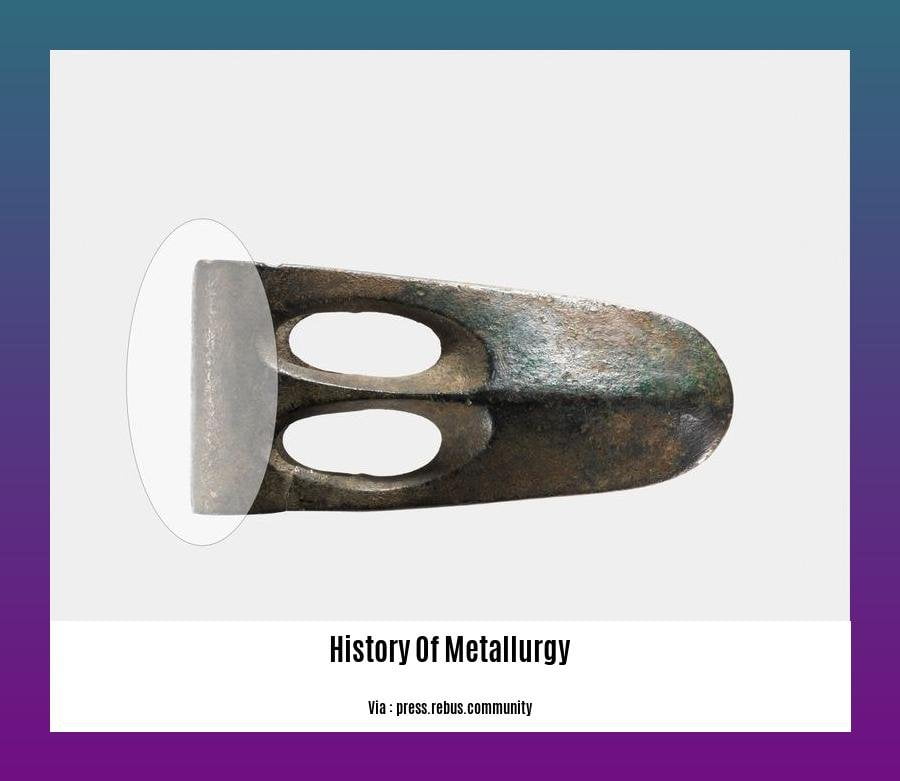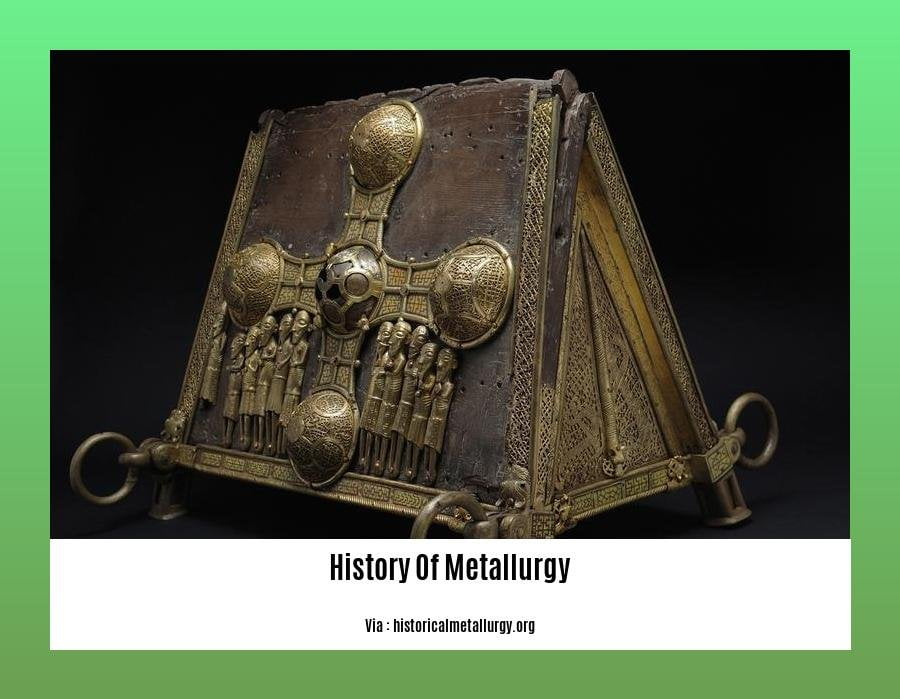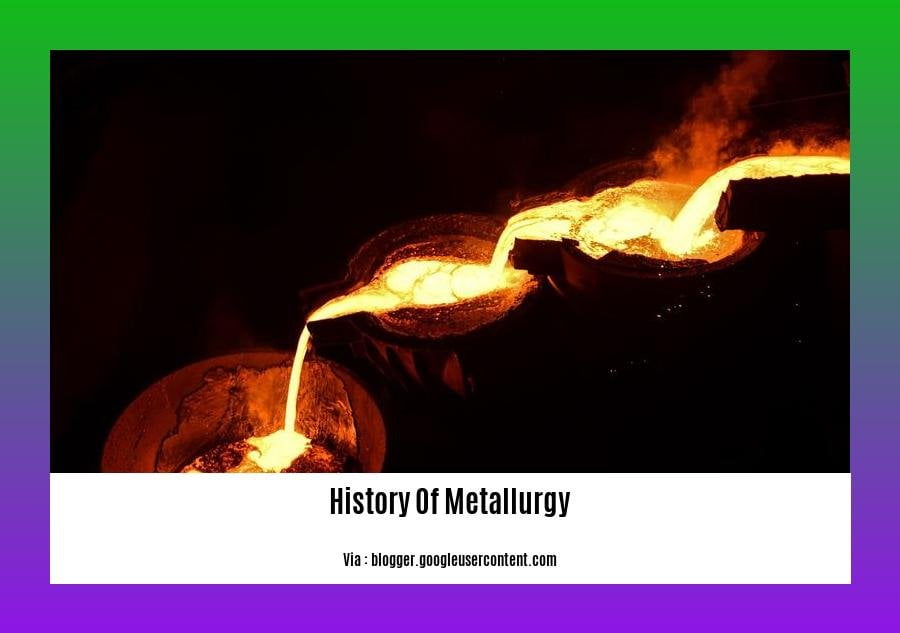Embark on a captivating journey through the annals of metallurgy in [Unveiling the Enriching History of Metallurgy: A Journey Through Its Milestones]. From ancient civilizations forging tools and weapons to modern breakthroughs in engineering and technology, discover the fascinating evolution of this scientific discipline that has shaped human progress throughout history.
Key Takeaways:
- Metallurgy harnesses the power of metals to shape our world.
- Native gold, silver, and copper were the first metals used by humans.
- Metalworking techniques evolved over time, leading to the Metal Age.
- Copper needs processing to be shaped, while gold and silver occur naturally.
- Metallurgy involves extracting metals from ores and creating alloys.
History Of Metallurgy

Uncover the captivating history of metallurgy, a journey that has shaped human civilization for millennia. From the earliest discovery of metals to the sophisticated techniques used today, let’s delve into the milestones that have marked this field’s evolution.
The Birth of Metallurgy
Humans first encountered metals in their native form, such as gold and silver. These malleable metals could be easily shaped into tools and ornaments. However, harnessing the power of other metals required more advanced techniques.
The Age of Copper and Bronze
The discovery of copper smelting around 5000 BCE marked a significant turning point. Copper, when heated and combined with tin, formed bronze, an alloy stronger than either metal alone. This ushered in the Copper and Bronze Ages, where these metals played a crucial role in weaponry, agriculture, and art.
The Iron Revolution
The development of iron smelting around 1200 BCE revolutionized metallurgy. Iron, stronger and more versatile than bronze, became the foundation of tools, weapons, and infrastructure. The Iron Age marked a turning point in human history, enabling large-scale construction and agricultural advancements.
The Dawn of Steel
In the 17th century, the development of techniques to control the carbon content in iron led to the birth of steel. Steel’s superior strength and durability made it ideal for building railways, bridges, and skyscrapers, paving the way for the Industrial Revolution.
Modern Metallurgy
The 20th century witnessed rapid advancements in metallurgy. New alloys were developed, such as stainless steel and lightweight aluminum alloys, expanding the applications of metals in industries ranging from aerospace to energy.
The Future of Metallurgy
Metallurgy continues to evolve, with ongoing research into nanomaterials, advanced manufacturing techniques, and sustainable practices. As we look to the future, metallurgy holds the key to unlocking new possibilities in various fields, shaping the progress of human civilization for generations to come.
Explore the history of metal and trace the roots of this influential genre.
Dive deep into the History Of Metal Music and uncover the evolution of this captivating musical style.
Discover the riveting History Of Metallica and witness the rise of one of the most iconic bands in metal.
Uncover the History Of Metal Documentary that reveals the untold stories behind this genre’s legends.
Trace the History Of Metals Timeline and explore the chronological development of metal music.
Embark on a journey into the History Of Metal And Horror, where these two genres intertwine to create a haunting musical experience.
Immerse yourself in the History Of Metalworking and discover the ancient art of crafting metal.
Unveil the fascinating History Of Metal Detectors and learn about the technological advances that have revolutionized treasure hunting.
Iron Age: The Rise of Steel and Forging Techniques

Iron Age
Imagine a world without steel, a material that shapes our modern lives. The Iron Age, a groundbreaking era that began around 1200 B.C., marked the transition from bronze to iron as the primary metal for tools and weapons.
The Birth of Iron
Iron, unlike copper and tin (the components of bronze), has a higher melting point, demanding advanced smelting techniques. Ancient metallurgists devised innovative furnaces capable of reaching the scorching temperatures required to melt iron ore.
Forging and Steel
Forging, the process of shaping hot metal by hammering, played a crucial role in the Iron Age. It allowed skilled artisans to craft weapons with exceptional strength and durability. As techniques evolved, the discovery of steel, an alloy of iron and carbon, revolutionized metallurgy. Steel’s superior hardness and toughness made it the ideal material for tools and armor.
Societal Impact
The widespread adoption of iron tools transformed agriculture, enabling farmers to cultivate larger areas of land and increase crop yields. Iron weapons gave rise to powerful armies and the expansion of civilizations. Trade flourished as iron became a valuable commodity, fostering economic growth.
Key Takeaways:
- The Iron Age began around 1200 B.C. in the Mediterranean and Near East.
- Iron replaced bronze as the primary metal for tools and weapons due to its strength and versatility.
- Advanced smelting techniques were developed to melt iron, which has a higher melting point than copper or tin.
- Forging, the process of shaping hot metal by hammering, enabled the creation of durable iron tools and weapons.
- The discovery of steel, an alloy of iron and carbon, revolutionized metallurgy, leading to tools and armor with superior hardness and toughness.
- The Iron Age had significant societal and economic impacts, transforming agriculture, warfare, and trade.
Sources:
Metallurgy in Civilizations
Metallurgy has left an indelible mark on the course of human civilization. From the initial use of native elements like gold and silver to the advanced techniques of today, the manipulation of metal has spurred significant advancements across various spheres of human existence.
The need to innovate and discover new materials has been a driving force in the evolution of metallurgy. As civilizations progressed, the search for materials with improved strength, durability, and other properties led to the development of alloys and the refinement of existing techniques. The emergence of iron smelting and the mastery of steel production are prime examples of such advancements.
Metallurgy has played a significant role in shaping economies and social structures. Mining and smelting operations established trade and brought forth economic prosperity. The production of weapons and tools had a transformative impact on military strategies and warfare tactics, influencing the rise and fall of civilizations. The introduction of metal alloys, such as gold and silver, as monetary systems further exemplifies the deep-rooted connection between metallurgy and financial systems.
Moreover, metallurgical innovations have facilitated the flourishing of art and culture. The intricate metalwork of ancient civilizations, including the Egyptians, Romans, and Chinese, is a testament to the mastery of metalworkers. The use of gold, silver, and other materials in creating ornate sculptures, intricate pieces of jewelry, and decorative items added opuence and beauty to civilizations.
The history of [Metallurgy in Civilizations] is a testament to human ingenuity and the relentless pursuit of progress. As we look to the future, metallurgy holds the key to further breakthroughs and the development of advanced materials that will shape the next chapter of human civilization.
Key Takeaway:
- The development of metallurgy has been instrumental in the progress of human civilization, influencing various aspects of life, including technology, economies, and art.
- The search for improved materials and the development of new techniques have been central to the evolution of metallurgy.
- The transformative impact of metallurgy can be seen across different spheres, from the creation of tools and weapons to the rise of trade and the flourishing of art and culture.
Relevant URL sources:
Modern Metallurgy and Its Role in Technological Revolutions
From ancient blacksmiths to modern-day engineers, humans have harnessed the power of metallurgy to shape their world. The story of metallurgy is one of innovation and progress, where new discoveries and breakthroughs have paved the way for technological revolutions.
The Rise of Modern Metallurgy
The Industrial Revolution brought about advancements in metallurgy that had a transformative impact on society. The development of new smelting techniques and the invention of steelmaking processes enabled the mass production of iron and steel. These materials became essential for building railroads, bridges, ships, and other infrastructure that connected people and facilitated economic growth.
Alloy Development and Its Impact
The discovery of new alloys, such as stainless steel and aluminum, further expanded the capabilities of metallurgy. Stainless steel’s resistance to corrosion made it ideal for food processing and medical applications, while aluminum’s lightweight and strength-to-weight ratio revolutionized transportation and aerospace industries. These alloys have played a crucial role in shaping our modern world, from kitchen appliances to aircraft wings.
Metallurgy in the Digital Age
In the digital age, metallurgy continues to play a vital part in technological progress. The development of electronic materials, such as semiconductors and superconductors, has made possible the miniaturization of electronic devices and the exponential growth of computing power. Advanced metallurgy techniques are also essential in creating solar panels, batteries, and other renewable energy technologies that will shape our sustainable future.
Key Takeaways:
- Metallurgy has a rich and multifaceted history, with breakthroughs throughout the ages driving technological progress.
- Modern metallurgy enabled the mass production of iron and steel, leading to infrastructure development and economic growth.
- Alloy development, such as stainless steel and aluminum, expanded the capabilities of metallurgy and revolutionized industries.
- Metallurgy plays a crucial role in the digital age, facilitating the miniaturization of electronics and the development of renewable energy technologies.
Sources:
- The History of Metallurgy: From the Stone Age to the Present
- Modern Metallurgy: Shaping the Digital Age
FAQ
Q1: When did the Iron Age begin and where did it originate?
A1: The Iron Age began around 1200 B.C. in the Mediterranean region and the Near East.
Q2: What was the significant advantage of iron over bronze during the Iron Age?
A2: Iron is stronger and harder than bronze, making it superior for tools and weapons.
Q3: How did humans extract iron from its ores during the Iron Age?
A3: Iron smelting furnaces were developed to melt iron at high temperatures, allowing the extraction of iron from its ores.
Q4: What were the societal and economic impacts of the Iron Age?
A4: The Iron Age led to improved agricultural productivity, increased trade, and the rise of new civilizations.
Q5: What are the four main branches of metallurgy?
A5: The four main branches of metallurgy are pyrometallurgy, hydrometallurgy, electrometallurgy, and biometallurgy.
- Sept 31 Myth: Unveiling Calendar Secrets - March 18, 2025
- How Long & Till December 18, 2025: Accurate Countdown Guide - March 18, 2025
- Discover Japanese Artists: A Complete History - March 18, 2025
















